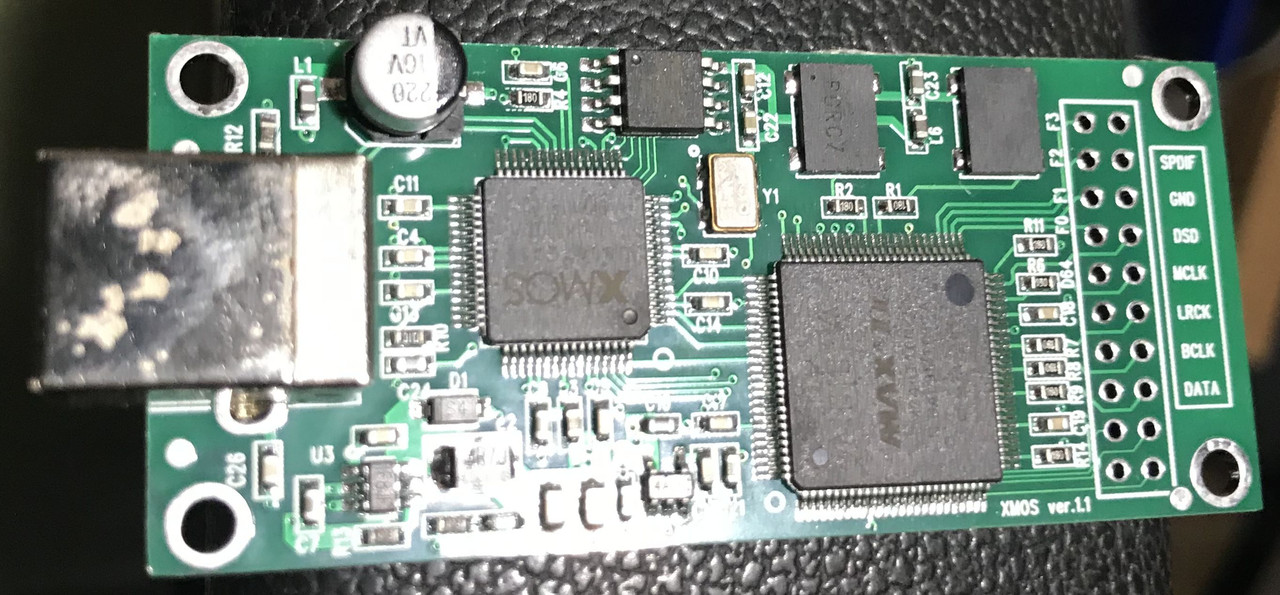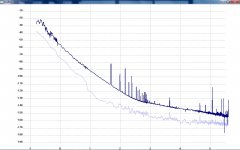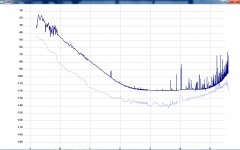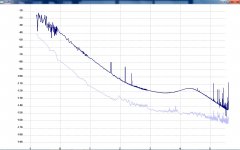Well, fwiw, this is my actual board ... a bit of a bastard "mixed breed" ... have not used it yet. Probably will first experiment by installing in a classic Philips CD player. Wanna try to connect it directly to the I2S of TDA dac vhip. Not sure how that'll go ...


The dac chip uses I2S, verses one of the older/alternate protocols?
If not, I2SoverUSB offers support for many different kinds of dac chips: http://jlsounds.com/uploads/I2SoverUSB v.III.pdf
If not, I2SoverUSB offers support for many different kinds of dac chips: http://jlsounds.com/uploads/I2SoverUSB v.III.pdf
how about the exasound U21? This was the gold standard until exasound stopped selling them. I have one for sale- see the swap meet.
I have heard sonic improvements after several hours (days, longer) of burn-in (or break-in). Current-day science and metrology and even psycho-acoustics have not been able (yet) to authenticate (quantify) given "modern" instruments and standardized criteria (what's in texbooks, white papers, etc).
Nevertheless, there are far too many audiophiles and audio enthusiasts (that are not paid-for writers and pro reviewers) that claim/report similar burn-in-phenomena effects to dismiss them as "total BS", irrelevant or (by extension) not statistically significant.
Nah, it's total BS and you just repeated a logical fallacy. Have fun, though.
......
Nevertheless, there are far too many audiophiles and audio enthusiasts (that are not paid-for writers and pro reviewers) that claim/report similar burn-in-phenomena effects to dismiss them as "total BS", irrelevant or (by extension) not statistically significant.
Perhaps you could cite examples of these effects manifesting themselves in arenas other than audio.
Most of the basic, fundamental issues in science are mysterious ... dark matter, dark energy, the Hard Problem of consciousness, how the mind works, etc, etc.Perhaps you could cite examples of these effects manifesting themselves in arenas other than audio.
With all these gaps in scientific knowledge and understanding, what makes certain hard-core audio objectivists conclude that ABX testing or blind testing or whatever is going to provide gospel ("scientific") truths?
It worked from the first time using both TDA1543 and TDA1387 dacs (installed in the same Philips CD player), being fed from a Linux PC.The dac chip uses I2S, verses one of the older/alternate protocols?
The sound fidelity was about the same as that from the default internal CD player's transport (i.e., CDM4 --> decoder chip). In fact, the USB may have sounded slightly inferior. But at least it worked, from the get-go, with no additional noise or distortion. And connection to Linux was transparent ( as always!).
The CD player was already quite heavily modded, with a discrete I/V and output stage, etc.
Most of the basic, fundamental issues in science are mysterious ... dark matter, dark energy, the Hard Problem of consciousness, how the mind works, etc, etc.
With all these gaps in scientific knowledge and understanding, what makes certain hard-core audio objectivists conclude that ABX testing or blind testing or whatever is going to provide gospel ("scientific") truths?
Nice non-answer.
how about the exasound U21? This was the gold standard until exasound stopped selling them. I have one for sale- see the swap meet.
The boards I have owned and played with are
1. U21
2. Waveio
3. Amanero
4. Jlsound first edition
5. Jlsound xu208
6. Diyinhk xu216
The audible differences between these boards are nothing short of shocking, even though I have always used them with some form of reclocking or fifo.
3. and .6 stayed very shortly in my system and 6. was just unlistenable.
Not very clear memories of WaveIO but it was clearly competent.
The Exa was my favourite and sounded pretty much identical to the original Jlsounds even though it lacked reclocking after the galvanic isolation. Lack of support makes it pretty much unusable for dsd today.
The current Jlsounds sounds a bit different to the original, even when both are used with external Crystek clocks. Both have strong points and I find it hard to state a preference. The only usb solution I find clearly preferable is the integrated Xmos in the Dam1941. Of course the integration probaby plays a big part as it eliminates the need for separate clocks.
There's a USB-to-I2S thread over on diyhifi.org. It's a bit dated now (2014), so not sure how relevant. But they weren't so impressed with Jlsound. I think they like XMOS stuff.The boards I have owned and played with are
1. U21
2. Waveio
3. Amanero
4. Jlsound first edition
5. Jlsound xu208
6. Diyinhk xu216
The audible differences between these boards are nothing short of shocking, even though I have always used them with some form of reclocking or fifo.
3. and .6 stayed very shortly in my system and 6. was just unlistenable.
Not very clear memories of WaveIO but it was clearly competent.
The Exa was my favourite and sounded pretty much identical to the original Jlsounds even though it lacked reclocking after the galvanic isolation. Lack of support makes it pretty much unusable for dsd today.
The current Jlsounds sounds a bit different to the original, even when both are used with external Crystek clocks. Both have strong points and I find it hard to state a preference. The only usb solution I find clearly preferable is the integrated Xmos in the Dam1941. Of course the integration probaby plays a big part as it eliminates the need for separate clocks.
Who know what (if) they ACTUALLY listened to ... or if they are reporting truthfully.
In any case, not sure how dated some of the your number-listed boards are? These devices evolve by the week, it seems. As I noted earlier, I bought mine in July and it is already replaced with an updated one (one that uses all MEMS osc. instead of mine which is one xtal and two MEMS). And even if the components remained unchanged, who know how many firmware updates were done?
There should be some hard-and-fast items to look for before Add-to-Cart. I think Markw4 might've mentioned a few:
--External (isolated) 5v power terminal
--High-quality crystal osc. (Accusilicon??)
--General board layout
I have owned these boards.
Exa U2I - Still in my system and my favorite by far. I can play DSD 1X files through a Buffalo 3 using JRiver. But only with the FIR set to Fast. JRiver says they are playing at 352.8 kHz 64 bit 2 channel. Sounds great to me. I get nervous every time Windows 10 has a major update.
Amanero - OK sound, still sitting on my bench
JLSounds V1 I think - Good board, I just preferred the U2I.
DIYINHK - Several older versions. They all sounded OK. I still use one for my desktop DAC. They were a good deal a decade ago when the options were limited and the prices for the competitors were much higher.
Exa U2I - Still in my system and my favorite by far. I can play DSD 1X files through a Buffalo 3 using JRiver. But only with the FIR set to Fast. JRiver says they are playing at 352.8 kHz 64 bit 2 channel. Sounds great to me. I get nervous every time Windows 10 has a major update.
Amanero - OK sound, still sitting on my bench
JLSounds V1 I think - Good board, I just preferred the U2I.
DIYINHK - Several older versions. They all sounded OK. I still use one for my desktop DAC. They were a good deal a decade ago when the options were limited and the prices for the competitors were much higher.
I think here I can contribute some.
These are phase noise plots taken at the MCLK output pin of a Diyihk DXIO 768k converter.
First is the 'default' output, with onboard (USB powered) supplies, and OLED display connected.
Onboard clocks are NDK SD 45/49MHz oscillators.
They get through a 74AC74 flip flop to be divided at the MCLK output by two, that is 22/24MHz.
Second is the same, divided by two output, but no OLED display included.
Third plot is the same MCLK, but an inner jumper selects a direct forward of the NDK SD oscillator, plus the provided external PS option is used. The frequency now 45MHz.
Have fun!
These are phase noise plots taken at the MCLK output pin of a Diyihk DXIO 768k converter.
First is the 'default' output, with onboard (USB powered) supplies, and OLED display connected.
Onboard clocks are NDK SD 45/49MHz oscillators.
They get through a 74AC74 flip flop to be divided at the MCLK output by two, that is 22/24MHz.
Second is the same, divided by two output, but no OLED display included.
Third plot is the same MCLK, but an inner jumper selects a direct forward of the NDK SD oscillator, plus the provided external PS option is used. The frequency now 45MHz.
Have fun!
Attachments
Last edited:
Here it is a quick look at the FOX Xpress0 45MHz/2, 22MHz output of an old version of a JLSounds USB/I2S converter board.
Attachments
Last edited:
As in the Diyinhk board, also the JLSounds board permits also the direct access to the original, undivided oscillator frequency, in this case a FOX Xpress0 45MHz oscillator. Here it is the phase noise spectra of the 45MHz original clock.
The noise floor is lower, that was the contribution of the on board flipflop in the JLS board.
Also it can be seen that the FOX oscillator is a synthetized one, with the characteristic 'skirt'.
The noise floor is lower, that was the contribution of the on board flipflop in the JLS board.
Also it can be seen that the FOX oscillator is a synthetized one, with the characteristic 'skirt'.
Attachments
Last edited:
Hello,
I'm looking for an Asynchronus USB to I2S boar to fed my amplifier boards based on TI TAS3251 (DSP+Power Amp on chip ; [design log] Neat 2x170W I2S in, I2C controlled, integrated DSP amp (TAS3251)).
I need on the I2S side 16 bits 48k. I curently run the protopype with a PCM2706 board
From the beginning of the thread, I have seen that a good candidate coule be USB digital interface AS318B PCM1536 DSD1024 compatible with Amanero Italy XMOS to I2S|Digital-to-Analog Converter| - AliExpress
I don't think I will put the extra money on the table for the JL sound one.
Are there some new good alternatives to consider ?
JMF
I'm looking for an Asynchronus USB to I2S boar to fed my amplifier boards based on TI TAS3251 (DSP+Power Amp on chip ; [design log] Neat 2x170W I2S in, I2C controlled, integrated DSP amp (TAS3251)).
I need on the I2S side 16 bits 48k. I curently run the protopype with a PCM2706 board
From the beginning of the thread, I have seen that a good candidate coule be USB digital interface AS318B PCM1536 DSD1024 compatible with Amanero Italy XMOS to I2S|Digital-to-Analog Converter| - AliExpress
I don't think I will put the extra money on the table for the JL sound one.
Are there some new good alternatives to consider ?
JMF
How are you going to play 44.1kHz clock family sample rates if you only accept 48kHz on the input side. ASRC? DSP on PC?
Regarding the USB board you linked to, IIUC the latest drivers and configuration info is at: Support – XING
Using the firmware configuration tool you might be able to reduce the I2S word size to 16-bits, IIRC it defaults to 32-bit word size. (Maybe more of a certain thing to be able to configure I2SoverUSb for 16-bits, especially if you check the manual first, but you said you don't want it...)
The linked Chinese board isn't too good IMHO if running on USB power. In that case the nice clocks performance is more or less canceled out by lousy USB power. It is possible to use a USB Y-cable or modify the board to run the board on clean +5v power. In that case the clocks work similar to those found in Topping D90 (and like D90 it takes them about 3-days to fully warm up after power-on, except unlike D90 both clocks don't both stay on at all times, so warmup starts for each clock whenever it is selected. Maybe not a problem if always using the 48k family clock).
Regarding the USB board you linked to, IIUC the latest drivers and configuration info is at: Support – XING
Using the firmware configuration tool you might be able to reduce the I2S word size to 16-bits, IIRC it defaults to 32-bit word size. (Maybe more of a certain thing to be able to configure I2SoverUSb for 16-bits, especially if you check the manual first, but you said you don't want it...)
The linked Chinese board isn't too good IMHO if running on USB power. In that case the nice clocks performance is more or less canceled out by lousy USB power. It is possible to use a USB Y-cable or modify the board to run the board on clean +5v power. In that case the clocks work similar to those found in Topping D90 (and like D90 it takes them about 3-days to fully warm up after power-on, except unlike D90 both clocks don't both stay on at all times, so warmup starts for each clock whenever it is selected. Maybe not a problem if always using the 48k family clock).
Thanks for the feedback and all good questions...
Maybe I was misled by the TAS3251 software. My understanding of the datasheet (https://www.ti.com/product/TAS3251), after having a second look, is that:
- my intention is to run the TAS3251 as slave of the USB-I2S board,
- It can synch its clocks either to 44.1 or 48kHz (filters I need do not allow the 88.2 - 96kHz freq),
- It can have 16, 20, 24, 32 bits depth. I have to recheck the outputs of the PCM2706, but I remember that looking at the I2S stream with the analyser, there were more than 16 bits.
So let's consider that 44.1 or 48kHz and 32 bits would be OK.
My boards can output 3.3V, 12V and 15V. Could power the USB-I2S board?
I don't have the intention to keep the system powered on when not used, so the clock won't be running for more than few hours, But I would be happy to have a better master clock thent the PC our RaspberryPi (hence the Asynch requirement).
Which USB-I2S boards could be considered ?
Best regards,
JMF
Maybe I was misled by the TAS3251 software. My understanding of the datasheet (https://www.ti.com/product/TAS3251), after having a second look, is that:
- my intention is to run the TAS3251 as slave of the USB-I2S board,
- It can synch its clocks either to 44.1 or 48kHz (filters I need do not allow the 88.2 - 96kHz freq),
- It can have 16, 20, 24, 32 bits depth. I have to recheck the outputs of the PCM2706, but I remember that looking at the I2S stream with the analyser, there were more than 16 bits.
So let's consider that 44.1 or 48kHz and 32 bits would be OK.
My boards can output 3.3V, 12V and 15V. Could power the USB-I2S board?
I don't have the intention to keep the system powered on when not used, so the clock won't be running for more than few hours, But I would be happy to have a better master clock thent the PC our RaspberryPi (hence the Asynch requirement).
Which USB-I2S boards could be considered ?
Best regards,
JMF
USB power is +5v. One could drop +12v or +15v down to +5v with a small regulator. Probably best to choose whichever rail is cleanest and derive +5v from that.
If a USB board with good clocks is desired, the Chinese board with AS318B clocks or else I2SoverUSB with NDK SDA clocks are the two best stock boards. If lesser clocks are okay then a real (not Chinese clone) Amanero running on clean +5v power probably isn't too bad, but it costs more than I2SoverUSB. The cheaper Chinese boards are all junk in terms of clock jitter and lack of ASIO drivers. Diyinhk USB boards I have seen may use NDK SDA clocks but the implementation of them is not that good. Their jitter sounds significantly worse to me than one gets with I2SoverUSB.
If a USB board with good clocks is desired, the Chinese board with AS318B clocks or else I2SoverUSB with NDK SDA clocks are the two best stock boards. If lesser clocks are okay then a real (not Chinese clone) Amanero running on clean +5v power probably isn't too bad, but it costs more than I2SoverUSB. The cheaper Chinese boards are all junk in terms of clock jitter and lack of ASIO drivers. Diyinhk USB boards I have seen may use NDK SDA clocks but the implementation of them is not that good. Their jitter sounds significantly worse to me than one gets with I2SoverUSB.
Thanks Markw4 for the advices. I will have a second look to the I2SoverUSB, but should go to the Chinese board with AS318B clock.
Also thanks for the eyes opening questions.
JMF
Also thanks for the eyes opening questions.
JMF
- Home
- Source & Line
- Digital Line Level
- Purchase of usb I2S converter




